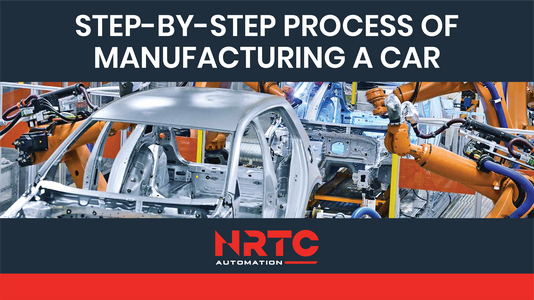Step-by-Step Process of Manufacturing a Car
Have you ever wondered what the process of manufacturing a car looks like?
From design to launch, it typically takes around two to five years to make a car from start to finish. This long timeline is to ensure the car is in sound condition for public use as well as to develop original designs that will spark interest within a large market.
Car manufacturers have had the assembly process down pat since Henry Ford’s innovation on the assembly line. However, design and material use have become more intricate and complex as technology develops and demand changes.
Each car manufacturer has its own process, but NRTC Automation has outlined the standards of making a car, from gathering raw materials to displaying the car on the sales floor. Read more about the car production process below!
Step-by-Step Process of Manufacturing a Car
RAW MATERIALS
Raw materials must be compiled to transform the car from an idea to a reality. Many car manufacturers are looking for more sustainable, as well as lightweight and cost-effective, materials for their cars to keep up with the demand for greener products.
DESIGN & ENGINEERING
Automobile design must respond to the public’s needs and desires for a car. Once the design is drafted, it’ll go through many revisions to perfect it.
The interior and exterior must be fashioned so that it is attractive to potential buyers while also including innovative technologies that make the car newsworthy and competitive to other brands.
Small models will be made in 2D and 3D forms to test the car’s design. Engineers will test for aerodynamics, safety, hot and cold weather, fuel economy, electrical functionality, cost analysis, and more.
Once the design and engineering specs have been approved, then the manufacturing process can begin.
MANUFACTURING
The sheet metal parts for the bodywork are created and stamped by robots. These parts form side frames, doors, hoods, and roofs, which are later added onto the main frame of the car.
Once the frame is created and the parts are ready to be assembled, the car will be loaded onto a production line.
The car will travel along a moving assembly line in a factory as robots and people work on them. Manufacturing plant workers will attach parts to the car and may work alongside robots for certain tasks. Robotic work cells will work alone to weld, solder, screw, and glue parts onto the car.
Once the parts of the body are manufactured onto the car, it will undergo detailing. This includes cleaning, layering chemical formulas for protection against corrosion and scratches, and painting.
Finally, the engine, transmission, axles, and exhaust systems are installed into the car and the tires are furnished so the car can stand on its own.
TESTING & QA
Now that the car is ready to drive, it will be tested for quality assurance and safety.
The vehicle is checked for any imperfections or inconsistencies in the interior and exterior design.
The car will run through a series of tests similar to those given at a DMV: the engine is started and stopped several times, the steering alignment is adjusted, the headlights are checked for brightness and reach, brakes are tested for safety, and more.
Then, the car will be tested in heavy water pressure to find leaks.
The car’s programming will be tested, and the electrical units will be checked to ensure safety and accessibility.
Finally, crash testing will be executed to observe how the car handles impacts, and to test airbag and seat belt performance.
If the car requires no further tweaks in design and production for safety, then the car can be presented to the market.
LAUNCH
After performing market research, developing a marketing theme, and defining the price of the car, the car will be produced for car dealerships and private dealers to sell to the public.
Cars are a fascinating and cutting-edge technology.
They are commonplace now, but cars are an engineering feat that has transformed the way we travel.
Understanding the process of manufacturing a car from design to launch will enable you to have a new appreciation for automobile design and function.
GET THE PARTS YOU NEED WITH NRTC AUTOMATION.
NRTC Automation offers high-quality parts manufacturing for any industry. If you need parts built, engineered, and shipped to your facility, NRTC will provide all services for as long as you need.
We also provide a customized solution for the decommissioning and tear out of your manufacturing and industrial assets. Our focus is on minimizing disruption and downtime in the work area while emphasizing safety, speed, and efficiency. Our additional robotic services help ensure full adoption of automation solutions and seamless integration into your workplace.
Contact NRTC Automation today to get the parts you need.
Reach out to us below to see how NRTC Automation can help with you car manufacturing needs

